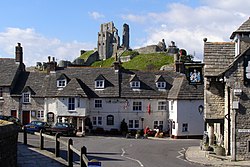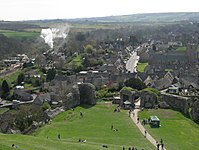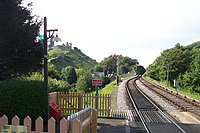Corfe Castle, Dorset
| Corfe Castle | |
| Dorset | |
|---|---|
 Corfe Castle | |
| Location | |
| Grid reference: | SY957823 |
| Data | |
| Population: | 1,355 (parish, 2011) |
| Post town: | Swanage |
| Postcode: | BH19 |
| Dialling code: | 01929 |
| Local Government | |
| Council: | Dorset |
| Parliamentary constituency: |
South Dorset |
Corfe Castle is a village in Dorset, named from its famous ruined castle, Corfe Castle. The village and castle stand over the Corfe Gap, a gap through the Purbeck Hills on the route between Wareham and Swanage. The village sits in the gap below the castle, five miles south-east of Wareham, and the same distance west of Swanage. Both the current main A351 road from Lytchett Minster to Swanage and the Swanage Railway thread their way through the gap and the village.
The village is constructed almost completely from the local grey Purbeck limestone and comprises two main streets, East Street and West Street, linked at their north end at the Square.
The wider civil parish stretches across the width of the Isle of Purbeck, with coasts facing both the English Channel and Poole Harbour. It therefore includes sections of both the low-lying sandy heathland that lies to the north of the castle, and the rugged Jurassic Coast upland to the south. From the southern shore of Poole Harbour it encompasses some of its little islands; Furzey, Green, Long and Round Islands.
The village and castle are part of Corfe Castle Hundred of Dorset.
Contents
History
Burial mounds around the common of Corfe Castle suggest that the area was occupied from 6000 BC. The common also points to a later Celtic field system worked by the Durotriges tribe. Evidence suggests that the tribe co-existed with the Romans in a trading relationship following the Roman invasion c. 50AD.[1]
The name "Corfe" is derived from the Old English word ceorfan meaning "to cut" or "carve", referring to the gap in the Purbeck hills where Corfe Castle stands.
The former royal status of Corfe brought it privileges and a borough charter which gave the borough the right to elect two members of Parliament. In the 17th and 18th centuries, with Bankes family owned much of the property in the borough and thereby controlled most of the votes, so that the own was considered a 'pocket borough', one of those rotten boroughs whose right to appoint members was in the pocket of one man. The Bankes family was able to ensure that at least one of the MPs returned to the House of Commons was a member of the family or a Bankes nominee. The Reform Act 1832 abolished the rotten boroughs and Corfe lost its direct representation.
In the 18th century the extraction of clay, known as 'Purbeck Ball Clay' developed as an industry in the village, with activity expanding significantly in the middle of the century with the arrival of William Pike, a merchant from Devon. In 1791 Pike signed a five-year contract with Josiah Wedgwood to supply 1200 tons of clay and search for further deposits.[2] From the 1796 Corfe Castle Census of the 96 men involved in local industries and living in the town, 55 were clay cutters. Clay extraction continued to provide a major employment for the local population until the 20th century.
Parish church
The Church of St Edward stands in the heart of the village; named for King Edward who was murdered in Corfe in 978 at the age of 14 or 15, and soon afterwards hailed as a saint.
Within the church is an alabaster reredos inset with carvings in white marble, designed by the renowned Victorian architect George Edmund Street R.A., which was presented by Lord Eldon in 1876.[3]
Sights about the village
The National Trust runs a shop and a tearoom in the village. The Corfe Model Village, located on the village square, is a 1:20 scale model that shows what the castle and village would have looked like in 1646 before the castle was slighted.[4]
A cross in the square commemorates Queen Victoria's Diamond Jubilee of 1897. Next to the cross is a defunct village pump, bearing the village's coat of arms.[5]
Corfe Castle
- Main article: Corfe Castle
The castle stands above the village and dates back in some form to the 10th century. It was the site of the murder of King Edward the Martyr in 978.
During the Civil War, the castle was a Royalist stronghold and was besieged twice, in 1643 and again in 1646. After the war the castle was slighted by order of Parliament so that it coould no longer be of military value.
Corfe Castle is today owned by the National Trust and is opened to the public.
Transport links
The main route through the village is East Street which forms part of the A351 main road taking traffic to Wareham in the north and Swanage in the south. Separating the two streets is an area of common land called "the Halves".
Corfe Castle railway station lies to the east of East Street, adjacent to the village centre. Originally the only intermediate station on the London and South Western Railway's branch line from Wareham to Swanage, the station is now a stop on the Swanage Railway, a heritage railway operating a steam locomotive. The railway links the tourist centres of Corfe Castle and Swanage with each other, and with a park and ride site at Norden station just to the north of Corfe Castle.
Cultural references
Numerous books have used the setting of this romantic gap in the hills and its haunting castle ruins.
- Enid Blyton's Famous Five adventure stories often featured castles that were said to be based on Corfe Castle. Blyton was a frequent visotr here.
"Five on a Treasure Island (The Children's Film Foundation, 1957) was filmed in and around Corfe Castle, Corfe Castle Village and the Jurassic Coast (Durdle Door and Stairhole at Lulworth Cove)
- Pavane, a science fiction book by loca author Keith Roberts is set partly around the castle and similar events in an alternate history.
- Scary Bones meets the Wacky Witches of Wareham by Ron Dawson includes a story of a wicked wizard who has become part of the castle itself.
- Bedknobs and Broomsticks (1971 Disney film) has the village doubling as the fictional village of Pepperinge Eye.
- "Nuts in May", a 1976 play by Mike Leigh has the two main characters, Keith and Candice-Marie, pay a visit to the castle during their camping holiday.
- Am Ende des Schweigens ('At the End of the Silence'), a the German television thriller based on the novel by Charlotte Link, include scenes showing the backside of the castle and Oliver's Bistro in Corfe Castle Village
- Mary Queen of Shops has aan episode centred on Mary Portas revamping the village's convenience store.
- The Lady of Hay by Barbara Erskine.
Outside links
| ("Wikimedia Commons" has material about Corfe Castle, Dorset) |
- Corfe Castle Village
- Corfe Castle Parish Council
- Corfe Castle - information at the National Trust
- Purbeck Mineral & Mining Museum
References
- ↑ History. The Corfe Castle Chamber of Trade & Commerce. Retrieved 5 July 2008.
- ↑ Jones, Eric Lionel (2010). Locating the Industrial Revolution: Inducement and Response. World Scientific. p. 72. ISBN 978-9814295253. https://books.google.co.uk/books?id=-y_Jy8UvR-sC&pg=PA72&lpg=PA72&dq=josiah+wedgwood+corfe+castle+1791&source=bl&ots=zMbE5kJXrH&sig=QZnc5Z6H19gaWOyeY_sLnGaiOyI&hl=en&sa=X&ved=0ahUKEwjat6XL5-fKAhWJWhoKHe7-B4gQ6AEIMzAE#v=onepage&q=josiah%20wedgwood%20corfe%20castle%201791&f=false.
- ↑ Michael Habermann & Liane Hansen, 1996. Weekend Edition. National Public Radio; Alistair Hinton, 2000. "Kaikhosru Shapurji Sorabji."
- ↑ "Isle of Purbeck – Corfe Model Village". isleofpurbeck.com. http://www.isleofpurbeck.com/corfemvill.html. Retrieved 16 August 2007.
- ↑ http://www.villagepumps.org.uk/corfecastle.htm

